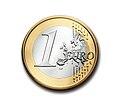This article relies largely or entirely on a single source .(September 2024) |
This is a list of currency of Spain. The official currency of Spain since 2002 is the Euro. The basic and most prevalent unit of Spanish currency before the Euro was the Peseta. The first Peseta coins were minted in 1869, and the last were minted in 2011. Peseta banknotes were first printed in 1874 and were phased out with the introduction of the Euro. [1] Prior to this was the Silver escudo (1865–1869), Gold escudo (1535/1537–1849), Spanish real (mid-14th century–1865), Maravedí (11th–14th century), and Spanish dinero (10th century).[ citation needed ]



